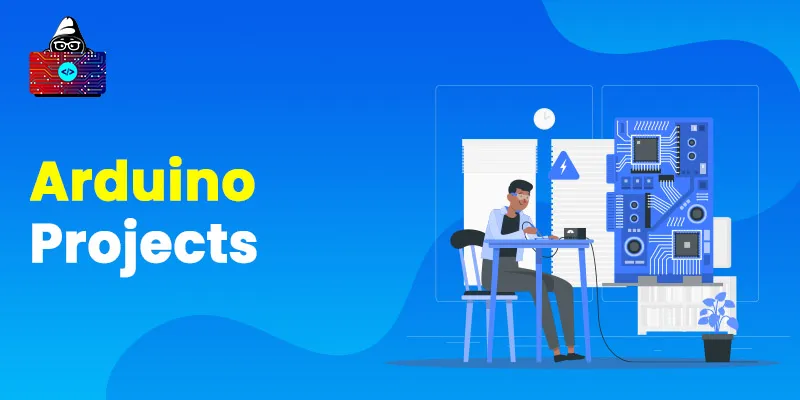If you are an electrical engineer and know how to work around electrical boards, you can create amazing projects to showcase your skills. For creating amazing projects, you can take the help of the Arduino platform.
If you are new to Arduino and want to build projects using Arduino, then this article is for you. It covers all the aspects of Arduino and also talks about some innovative project ideas.
Now, it’s time to get some important information about Arduino, its IDE , various types, and major projects.
What is Arduino?
Arduino is an open-source, programmable circuit board that supports every hardware and software efficiently. Arduino takes input in the form of light on a sensor, a finger on the button, or any message, and then turns it into an output, such as activating a motor, turning on the light, or publishing something online.
You provide necessary instructions to the microcontroller available on the board using Arduino programming language, and Arduino software (IDE). Arduino has been the brain that works behind thousands of projects and is capable of handling from small to complex scientific instruments. It has a wide and active community of various students, artists, and hobbyists that gathered together to contribute to the Arduino platform with incredible information that will help upcoming users.
Ivrea Interaction Design Institute has launched the Arduino as a tool for fast prototyping that helps students. Now, you can use Arduino for a simple projects for IoT applications, 3D printing, and embedded environments.
Why Use Arduino?
Arduino is preferred over other boards due to its accessible user experience. Till now, Arduino has been used in thousands of projects and applications.
Whether you are a beginner or an experienced IT professional (embedded system engineer), you can easily work and get along with Arduino due to its flexibility. It allows you to create low-cost scientific instruments and several embedded system designers and architects for building interactive prototypes.
Also, many musicians make use of Arduino for experimenting with new musical instruments. Some users use Arduino for learning new things like robotics and machine learning. Arduino helps in simplifying the process of working with microcontrollers.
It offers the following advantages:
- Inexpensive
When compared to other microcontroller platforms available in the market, Arduino offers cost-effective solutions. You will be able to assemble the least expensive version of the Arduino module by hand. Also, the pre-assembled Arduino modules are available at a cost of less than $50, making them affordable for college students.
- Cross-platform
The Arduino Software (IDE) can be used on various operating systems such as Windows, macOS, and Linux. On the other hand, most microcontroller systems are compatible only with Windows OS.
- The simple, clear programming environment
Whether you are a beginner or an experienced embedded system engineer, you can easily and efficiently use the Arduino Software (IDE) due to its flexibility.
- Open source and extensible software
The Arduino software is open-source, which allows you to extend its functionality by making desired changes to the source code. You can expand the features with the help of the C++ libraries .
- Open source and extensible hardware
The Arduino boards are published under a Creative Commons license that will help the experienced designers for creating customized modules by extending their functionality. Also, new users are capable of building breadboards.
What Makes Up an Arduino Board?
The Arduino board is a circuit board that is available with various functionalities. You can find a wide range of Arduino boards offering different features and you can choose any of the available boards as per your project requirements.
In this guide, we are explaining the Seeeduino V4.2 board and how it is different from the Arduino UNO. Seeeduino V4.2, as compared to the Arduino UNO, it will offer you some additional functionalities and features which we have highlighted in red in the above image.
1. USB Input
You can use the USB Port in order to connect the board to your PC for programming and for powering up the Arduino board. This USB connection is one of the most crucial things as it will help you to upload your code onto your Arduino board.
2. DC Input
The DC power jack helps in powering up the Arduino board from a wall adapter for supplying more power to your project whenever required.
3. Grove Connectors
As we are considering our customized Seeeduino board, you can only find the Grove connectors on this. It will provide you with a variety of sensors/devices that work seamlessly using the I2C or UART connection. The Grove connectors can be plugged in the modules so that you can use it with the Arduino without the need for any soldering or jumper systems.
4. 3.3V and 5V Pins
As the name specifies, the 3.3V and 5V pins are used for supplying the volts of power to your modules.
5. GND pins
With this GND (stands for Ground) pin that is specially used for grounding your circuit and is at zero voltage as compared to the power supply.
6. Analog Pins
The analog pins will read the entered signals using an analog sensor such as a light sensor and then help in converting it into a digital value.
7. 7 – Digital Pins
On the Seeeduino or Arduino UNO, the digital pins are available on pins 0 to 13 which are basically used for reading the digital inputs such as pushing a button and digital output like turning on an LED.
8. System Power Switch
You can find this switch only on our customized Seeeduino boards that will help in changing the logic level and operating voltage of the board to either 5V or 3.3V.
9. Reset button It allows you to reset the board and code that is being uploaded on your Arduino board.
10. RX/TX Indicator
It is also known as the Transmit and Receive indicator. The TX and RX LED indicators that will start working automatically and let you know whenever the board starts sending or receiving data.
11. Microcontroller
It is the brain of the Arduino board that can be used by the users to program Arduino for executing commands based on the underlying code.
How to work with Arduino IDE?
After the introduction to the Arduino boards, now it’s time to move on to the software for Arduino for programming and interacting with various sensors. One of the commonly used software for Arduino programming in Arduino IDE software.
Features of Arduino IDE software
- Using Arduino IDE, you can write and upload code on your Arduino board efficiently. It is a cross-platform program allowing you to run code on various platforms, such as Windows, macOS, and Linux. You can use this software along with an Arduino board such as Seeeduino V4.2.
- This program works on a simplified version of C++ offering a wide range of features such as syntax highlighting and others for easier understanding of the program and coding and making it a perfect all-rounder solution for beginners to begin with programming and coding.
- Once you start writing the code, you can load that code on your Arduino IDE with the help of a USB cable with a click of a button.
Types of Arduino
Below we have mentioned four types of Arduino microcontroller boards that are commonly used by designers and embedded system engineers for creating innovative applications:
- Arduino Uno Rev3,
- Seeeduino V4.2
- Seeeduino Nano
- Arduino Nano v3
How to Choose the Right Arduino for Your Project?
Now you are fully aware of the hardware and software part of the Arduino board, now it’s time that we move forward to choose the right Arduino board for your Arduino projects.
1. Arduino Uno Rev3
- If you want to practice your coding skills then Arduino Uno is the ideal board solution available for creating fun and engaging projects.
- It is one of the most commonly used and highly documented boards. Also, you will find many tutorials and projects to get started with Arduino Uno Rev3.
2. Seeeduino V4.2
- Seeeduino V4.2 is based on the Arduino UNO bootloader. It is affordable as compared to the Arduino UNO and also offers more features.
3. Seeeduino Nano
- If you want to use a lightweight and small board for your project, you can choose the Seeeduino Nano.
- The Seeeduino Nano is a compact board offering almost the similar functionality as offered by the Seeeduino V4.2/Arduino UNO.
4. Seeeduino Mega(ATmega2560)
- If you are looking for a bigger Arduino then the Seeeduino Mega should definitely be your choice.
- It is a powerful micro-controller with an ATmega2560 processor offering a large number of I/O pins.
- It comes with 70 digital I/O, along with 16 analog inputs, 14 PWM, and 4 hardware serial ports.
Best Arduino Projects
In this section, we have discussed some of the best Arduino project ideas that have minimal requirements.
1. Arduino Music Instrument
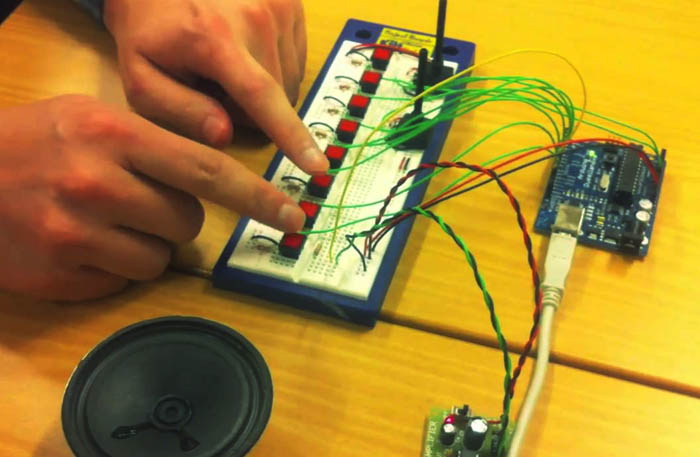
This project mainly focuses on gesture control and hardware for controlling the Arduino UNO R3. In this project, you can use the Flick board, which is a PCB that helps to detect gestures from a distance of more than 15cm in 3D space.
If you want to create a circle, you can swipe your hand in a circular direction and Flick will detect the hand movement. It will be able to control electronic devices such as computers, TV, music system, and many more. For this project, you need basic knowledge of Flick along with Arduino UNO for creating a musical keyboard like Casio!
Project Requirements:
- USB Cable Type A to B – 30CM Black
- Arduino IDE Software
- Mono Enclosed Speaker 2W 6 Ohm
- Flick Large – Standalone 3D Tracking and Gesture Breakout
- Resistor 4.75k ohm
- Capacitor 10 nF
- 3.5 mm Jack to 3 RCA Adapter Cable – 150mm
2. Arduino UNO Fingerprint Door Lock
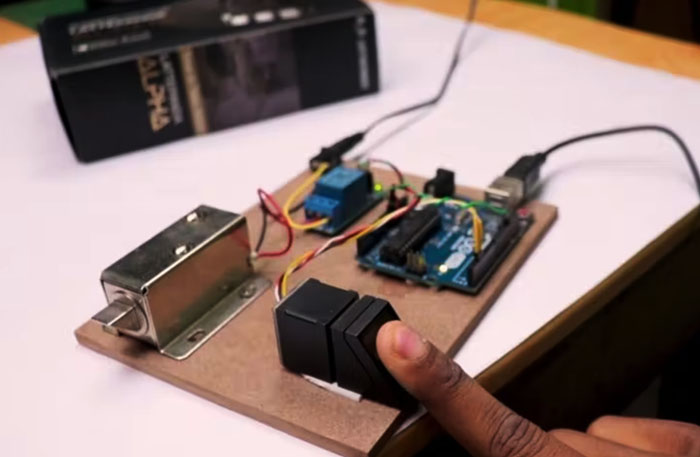
It is one of the most popular Arduino projects that can help you level up your skills. This project is about creating a fingerprint security door lock within budget. You will require the basic board and below-mentioned things for creating the project. You need to work on the input and output keys of the Arduino board so that the door will open only on the specific fingerprint.
Project Requirements:
- Grove – Fingerprint Sensor
- Grove – Infrared Reflective Sensor
- Grove – Servo
- Energy Shield
- Grove – LCD RGB Backlight
3. Arduino Robot Car

Creating a robot car is one of the exciting projects for every beginner and the project includes the usage of every concept you have learned so far. So you can use all their creativity to work on your robot car by combining the features of DC motors and Arduino.
Project Requirements:
- Grove – I2C Motor Driver V1.3
- 12V High Torque DC Motor
- Robot Car Wheel
- Breadboard Clear – 8.2 x 5.3cm
- Breadboard Jumper Wire Pack(241mm 200mm 160mm 117mm)
4. Arduino UNO Handheld Game Console
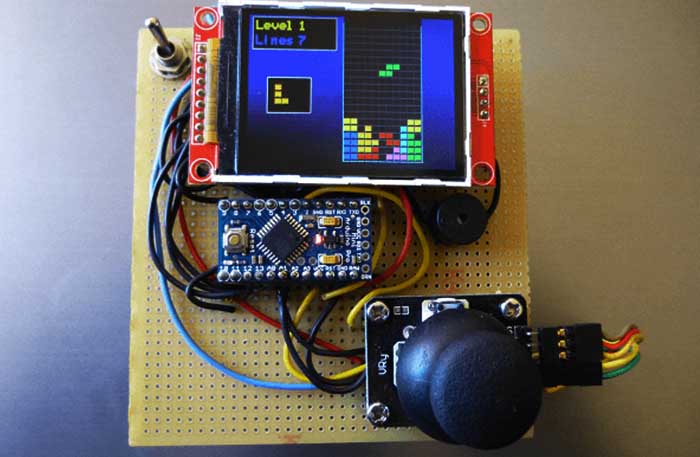
Project Requirements:
- Li-Ion Battery
- ATmega328P Microcontroller
- 2 x MAX7219CNG
- Bi-color Dot Matrix Display
- 6 x Push Buttons / Tactile Switch
- Grove – Buzzer
- 5 x 5mm LED
- 15 x Resistor 10k Ohm
- 4 x Capacitor 10 pF
- 2 x Capacitor 1 µF
- 3 x OC Base
- 165mm x 73mm PCB Board
5. UNO Home Automation
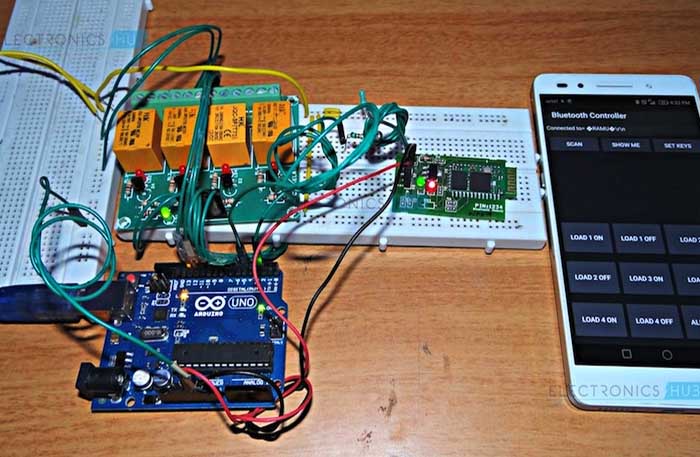
This is among the best Arduino projects to develop if you are interested in automation. It will allow you to automate your home appliances for making a smart home. With the help of Arduino and some modules, you can create an application that will control the electrical appliances with a single click on your application.
Project Requirements:
- Bluetooth Module HC-05
- Grove – 4 Channel SPDT Relay
- Home Automation Android APK
- Arduino IDE Software
Conclusion
Every appliance from TV to satellites have an embedded system that helps them to work. Creating such applications requires strong Arduino and embedded system knowledge. From a beginner’s perspective, working directly on complex applications is not recommendable as it will require great control of the concepts. It is better for a beginner to start with a small project where they will improve their skills and handle complex projects.
In this article, we have mentioned a few project ideas that you can start and test your skills. These Arduino projects have basic system requirements so that you do not have to spend much on creating projects.
People are also reading:
- Best AWS Projects
- Best Machine Learning Projects
- Top Django Projects Ideas
- Best Python Projects
- PHP Projects to Add to Your Resume
- Best SQL Projects for Database Developers
- JavaScript Projects for Beginners
- Best Data Science Bootcamps
- Web Development Bootcamps in 2022
- Exciting Web Development Projects
